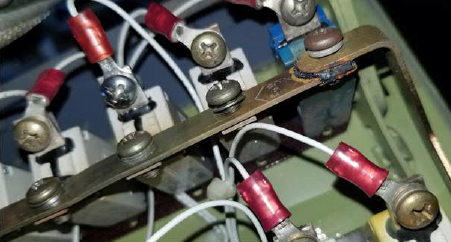Attention:
Owners, operators and maintainers of MHI RJ aviation model CRJ 550/700/701/702/705/900/1000 aeroplanes
| File Classification No.: | Z 5000-35 |
|---|---|
| RDIMS No.: | 18804849 |
| Document No.: | CASA 2022-05 |
| Issue No.: | 01 |
| Effective Date: | 2022-12-08 |
Purpose:
The purpose of this Civil Aviation Safety Alert (CASA) is to raise awareness of the improper assembly and torque values found on circuit breaker (CB) bar connections and CB to electrical bus bar connections. In addition, this CASA provides details of issues currently being experienced and the subsequent actions to correct these issues.
Background:
During a 5-week span from August to September 2021, an operator experienced three events, in their CRJ700 fleet, of melted bus bars on circuit breaker panel #2 (CBP2). The inflight issues included several engine indication and crew alerting system (EICAS) messages, hydraulic system low pressure messages, temporary hydraulic system failures, and wing strobe lights out of synchronization.
These events caused increased crew workload, and, in one case, sluggish flight controls were experienced due to the inadvertent temporary loss of hydraulic system power. In another case, the loss of power to all circuit breakers (CBs) on one row in CBP2 was experienced, resulting in multiple system messages and failures.
The investigation of these events found loose connections, twisted bus bars, improperly torqued connections, and incorrect installation techniques. It was also discovered that the Aircraft Maintenance Manual (AMM) did not contain specific removal and installation instructions for CBs and bus bars, and the Electrical Standard Practice Manual (ESPM) only partially covered CB installation. As a result, changes were identified to introduce new AMM tasks, providing instructions for the removal and the installation of CBs and bus bars.
As an example, ESPM Sections 20-25 for CBs defines torque values, however, information is missing for the installation of CBs and bus bars. This leads to some personnel attempting to install CBs without removing the bus bars (or loosening them to make space), which results in "twisting" of the bus bars.
The manufacturer is working on updating the AMM and adding new tasks. They have also taken an action to issue an AMM temporary revision and publish a Wingspan article to provide more immediate awareness.
The revised AMM is scheduled to be published by December 2022 and will include the following new tasks:
- AMM Task 24-00-00-000-801 (Config A02) Removal of Bus Bars
- AMM Task 24-00-00-400-801 (Config A02) Installation of Bus Bars
- AMM Task 24-00-00-000-802 (Config A02) Removal of Circuit Breakers
- AMM Task 24-00-00-400-802 (Config A02) Installation of Circuit Breakers
Recommended action:
Care must be exercised when installing and securing the electrical connections of CB and bus bars especially in the Circuit Breaker Panels. All personnel engaged in this type of installation, should be aware of, and apply, the proper removal and installation procedures and techniques.
The specific installation procedures and precautions found in the revised AMM and the torque values provided in the ESPM must be used.
Additional information can be found in Service Bulletin (SB) 670BA-24-032 – Electrical Power - Circuit Breaker Panels (CBPs) – Torquing of the mounting screws on the terminals of the circuit breakers in CBP-1, CBP-1 lower, CBP-2 and CBP-2 lower.
Indication of burning due to arcing of loose (under torqued) bus bar connection.
Contact office:
For more information concerning this issue, contact a Transport Canada Centre; or contact Daniel Haughton, Continuing Airworthiness in Ottawa, by telephone at 1-888-663-3639, by fax at 613-996-9178 or by e-mail at TC.CAWWEBFEEDBACK-retroactionWebMDLN.TC@tc.gc.ca.
Original signed by
Jenny Young
Chief, Continuing Airworthiness
National Aircraft Certification
The Transport Canada Civil Aviation Safety Alert (CASA) is used to convey important safety information and contains recommended action items. The CASA strives to assist the aviation industry's efforts to provide a service with the highest possible degree of safety. The information contained herein is often critical and must be conveyed to the appropriate office in a timely manner. The CASA may be changed or amended should new information become available.
